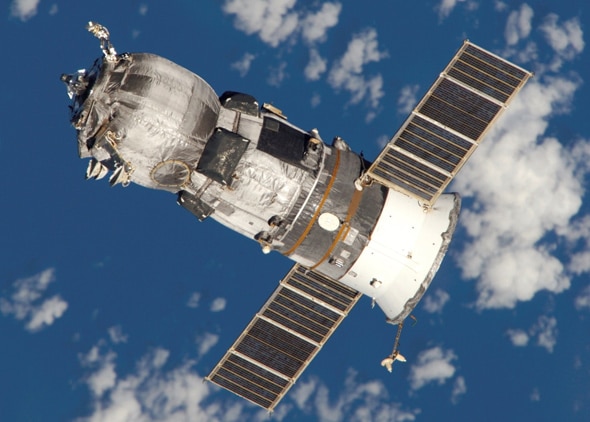Create a free profile to get unlimited access to exclusive videos, sweepstakes, and more!
Breaking: Failed Russian Space Capsule Will Re-Enter Earth’s Atmosphere
Thursday

Update, May 8, 2015, at 04:40 UTC: Via SpaceFlight101:
USSTRATCOM issued a precise Re-Entry Confirmation for Progress M-27M showing orbital decay (80km passage) to have taken place at 02:20 UTC +/-1 Minute. This puts the location of re-entry 830 Kilometers off the Chilean Coast (Center of the window), but given the speed the object was traveling, the decay location may be anywhere from 350 to 1,300 Kilometers off the South American Coast.
And that is that. We still don't know what went wrong with the Soyuz rocket or Progress module, though. Hopefully Roscosmos will get that straightened out as soon as possible, so that flights may resume safely.
Update, May 8, 2015, at 00:15 UTC: SpaceFlight101 has been posting a series of updates on the progress of the Progress, so to speak. Right now, it looks like several re-entry predictions are converging on roughly 02:00 UTC (10:00 p.m. tonight Eastern U.S. time) as the time it'll burn up. These should be taken with a grain of salt, as uncertainties are large.
On April 28, 2015, the Russian space agency Roscosmos launched an uncrewed Progress capsule loaded with supplies for astronauts on the International Space Station. Due to a malfunction that has yet to be identified, there was an event (possibly a tank rupture or small explosion) that generated debris and sent the capsule tumbling. Attempts were made to find a solution, but a few days later the mission was declared a failure.
And now, today, the Progress M27-M capsule is expected to re-enter Earth’s atmosphere. Things like this are notoriously hard to predict, but according to Roscosmos the window for re-entry is between 21:45 and 03:36 UTC (5:45–11:36 p.m. Eastern U.S. time) Thursday.
That’s a big window, and covers a vast amount of the planet. The ground track (the path of the capsule traced over the ground) is also hard to predict, but your best bets are Heavens-Above.com and N2YO. I’m not sure how accurate those sites will be as the capsule dips lower and the orbit decays, however.
In general, large satellites are designed to be de-orbited over the Pacific Ocean, a huge tract of uninhabited water. That gives engineers plenty of room to bring down the object. But in an uncontrolled re-entry, it could come down anywhere along its orbital track.
The Progress capsule is designed to break apart and burn up efficiently as it comes down. There are some bigger pieces that could survive to the ground, however. BUT—and this is a big but—the Earth is very, very large. The chance of a piece coming down and hitting anyone is extraordinarily small. First, the Earth is mostly water, so odds are it’ll burn up over an ocean.
Second, people (even houses and buildings) are tiny compared with the area of land around them, so the odds of a piece hitting anything are again pretty long.
I’m not too worried about this at the moment. I’ll be keeping an eye on those sites that track it, though. According to space aficionado Jonathan McDowell, most or all of the smaller debris has already come down, and he also wrote that it’s unlikely that debris will fall over North America or Europe.
The malfunction occurred during the final moments of the upper stage Soyuz booster placing the capsule in orbit. It’s not clear what happened exactly, but whatever it was generated dozens of pieces of debris and sent the capsule on a 12 RPM spin (see the video above, downlinked not long after the malfunction on April 28). The capsule was put on an elliptical orbit that dropped as low as about 187 kilometers above the Earth’s surface. Although thin, there is air up that high. That causes drag on the capsule, robbing it of orbital energy, dropping it down.
The process was slow at first, but accelerates as the capsule dips down lower every orbit. The exact amount of drag depends on many things, including the direction the capsule is facing (if it’s face on into the direction it’s moving, drag is lower than if it presents its larger side) and atmospheric conditions. That’s why the exact re-entry time is hard to pin down. At a velocity of 8 km/sec (5 miles/sec) it covers a huge amount of ground, so being off by even a minute means an error of hundreds of kilometers.
Stay tuned. I’ll update this as I learn more. In the meantime, I suggest following McDowell, Marco Langbroek, and Jeff Foust to keep up with the latest news.


























